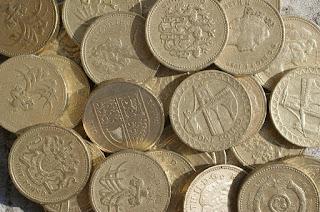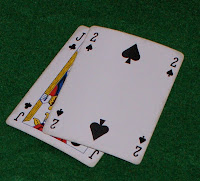 |
Top: The Ballroom, Assembly Rooms, Bath (2012)
Bottom left: Top left: Assembly Rooms, Bath (2012)
Bottom right: Dancers from La Belle Assemblée (1820) |
*This post was written in March 2012 and updated in September 2016 with new relative values based on 2015 data.*
While researching my posts about the
Bath Assembly Rooms, I found a list of subscription rates in a contemporary guide.
(1) I discovered that a season’s entry to the 28 dress balls being held in the 1815 season cost 14 shillings per person, a gentleman’s annual subscription to the reading and card room cost a guinea and a lady’s subscription to the card assemblies cost five shillings. Tea on ball nights cost an additional sixpence.
But what was a guinea? Was it worth more than 14 shillings? Was sixpence really the trivial sum that I assumed it to be? And how much would this be in today’s money?
Regency money
The main denominations were pounds, shillings and pence.
There were 20 shillings in a pound. Pounds were denoted by “£” or sometimes by “l”, standing for libra—a pound weight in Latin; shillings were denoted by “s”.
There were 12 pence or “d” in a shilling. The “d” stood for denarius, a small Roman coin.
A crown was worth five shillings; a half-crown, two shillings and sixpence.
The value of a guinea varied according to the price of gold, but by 1815, its value was fixed at 21 shillings.
This tells us that a gentleman’s annual subscription to the card room cost half as much again as a single person’s entry to all the dress balls for the season, but gives no indication of what amount this was in today’s money.
What would it cost today?
This is not a straightforward question to answer as there are many factors involved in translating prices from one time period to another. Not only prices, but income levels have changed. What seems like a small monetary value to us could represent a huge proportion of someone’s income back in 1815.
I have found the
MeasuringWorth website (2) very helpful in understanding the relative values of commodities and incomes from the Regency period compared with today. They have researched alternative ways of comparing relative worth between different time periods and have used historic data to create calculators to enable us to compare the cost of something in 1815 with today’s prices.
When Regency prices or incomes are quoted in books, a second figure is often included representing the amount 'in today’s prices'. This comparative amount is typically based on the retail price index (RPI). The RPI, or cost-of-living index, compares the cost of purchases of a typical household in 1815 with the cost in 2015. It is possible to get an idea of what something would have cost in today’s money by using this measure.
The RPI gives us the following values:
Subscription to the dress balls: 14s = £46.76, equivalent to a mere £1.67 per ball!
Gentleman’s annual subscription to the card and reading room: 1 guinea = £70.14.
Subscription to the card assemblies: 5s = £16.70.
Tea: 6d = £1.67.
Though interesting, these results are not as helpful as they could be, because they do not give any indication as to whether these sums were within a person’s means or not.
What was the real cost?
To include a measure of affordability, it is necessary to look at relative earnings. This is important because average wages today are higher than in 1815. For example, a teacher in 1815 would have earned about £51. (3) Using the RPI calculator, this would be £3,410 in 2015. However, the relative salary of a teacher in the UK today is much higher than in 1815, with a starting salary in excess of £22,000 (4).
The MeasuringWorth website uses average earnings to calculate an alternative relative value. Compared to an average 2015 salary, the relative values are now:
Subscription to the dress balls: 14s = £511, equivalent to £18.25 per ball.
Gentleman’s annual subscription to the card and reading room: 1 guinea = £767.80.
Subscription to the card assemblies: 5s = £182.80.
Tea: 6d = £18.28.
So how much did a Regency ball really cost?
A subscription to the dress balls at the Upper Rooms in Bath in 1815 cost 14 shillings, equivalent to 6 pence per ball. This represents about £1.67 in today’s money. However, I believe that the average earnings indicator can give us the best idea of the real cost, and this measure gives us a price of about £18 per ball. This seems surprisingly inexpensive, though the price is doubled when you include the cost of tea.
However, two things should be borne in mind. Firstly, this price was only available if you took out a subscription for the season; a ticket to a single ball for a non-subscriber cost five shillings, equivalent to a massive £182.80! The second is that the relative earnings calculator is based on average earnings. How affordable these things really were would have depended on an individual’s personal circumstances.
Rachel Knowles writes faith-based Regency romance and historical non-fiction. She has been sharing her research on this blog since 2011. Rachel lives in the beautiful Georgian seaside town of Weymouth, Dorset, on the south coast of England, with her husband, Andrew.
Find out more about Rachel's books and sign up for her newsletter here.
If you have enjoyed this blog and want to encourage me and help me to keep making my research freely available, please buy me a virtual cup of coffee by clicking the button below.
Notes
(1) From Feltham, John, Editor of the Picture of London, A Guide to all the Watering and Sea-bathing Places (1815).
(2) All calculations from MeasuringWorth.com.
(3) Salary details from Jeffrey G. Williamson, "The Structure of Pay in Britain, 1710-1911", Research in Economic History, 7 (1982), 1-54.
(4) Teacher salaries from Department of Education website.
Sources used include:
Feltham, John, Editor of the Picture of London, A Guide to all the Watering and Sea-bathing Places (1815)
Williamson, Jeffrey G, "The Structure of Pay in Britain, 1710-1911", Research in Economic History, 7 (1982)
MeasuringWorth website - for calculators of relative worth
The Old Bailey website - for details of coinage
Photographs © RegencyHistory






Very interesting and well explained. Thank you so much!
ReplyDeleteThank you for a very informative and interesting article!
ReplyDeleteThanks very much. Initially, I just set out to discover what a guinea was and became fascinated with the whole idea of calculating what the Regency balls would cost in today's money.
ReplyDeleteWonderfully helpful! thank you!
ReplyDeletehow wonderful of you to post such useful info.
ReplyDeleteThank you.
When I first started work in London in 1950 I was paid £2-10-0d per week from which was deducted 2/10½d for National Health. I was below the minimum tax bracket so I was tax free. My nett wage was therefore £2-7-1½d which believe it or not was quite a high wage for a boy of my age at the time.
ReplyDeleteSo it seems that from the early 1800's to the mid 20th century wages didn't rise all that much, but have since sky rocketed.
What memories the old LSD brings back, the money not the other stuff :o
The gold for guineas originally came from Guinea - hence the name. It was intended to be used as a one pound coin but the Mint discovered that the gold was purer than anticipated, so they marked the coin up by 5% ie to make it 21 shillings.
ReplyDeleteThe "Spade guinea" was the main gold coin in the latter part of the 18th Century (together with its multiples of two and five guineas, and its fractions eg half guinea). All that changed when the entire coinage was re-jigged in the Regency period and the pound of twenty shillings came back into prominence.
Thanks for this information, Mike. :)
DeleteWhen I married for the first time back in 1958 the tailor made suit for the occasion set me back 53 guineas (£55 13s 0d) which was around 3 weeks minimum weekly wage for a male aged 21. The same suit these days would set me back anywhere from $A3500 to $A4500 however the minimum weekly wage for a male aged 21 is nowhere near $A1200 + . I suppose everything is just relative ( whatever that means it's an expression I hear bandied about quite often) :)
ReplyDeleteThis is a classic example of where prices have gone up disproportionately compared to people's ability to buy. Taking into account average earnings helps to make more sense of past prices. Sounds like your 1958 suit was 'relatively' cheap!
DeleteAn excellent and most useful article. I ended up here because I was trying to get some idea of the value of the 25 Guineas that Mis Havisham gives to Joe Gargery for Pip's apprenticeship in 1814. It seems to work out to around 6 months wages for a school teacher. The current entry level salary for teachers in the UK is almost exactly £16,000, so this would have been a most generous £8,000 gift to Mrs Joe for her raising her orphaned brother "by hand".
ReplyDeleteThanks for the help.
I''m so glad that you found the blog pointed you in the right direction. The relative value of money is a fascinating subject.
DeleteIf you compare this with say theatre, cinema or concert prices today a subscription seems fairly reasonable. Afternoon tea in a tourist type hotel will set you back a bit too. Bath prices were much the same as for Leamington. The prices were set to what the market would bear I suppose and in the case of Leamington to recoup the expensive building costs incurred in this New Town!
ReplyDeleteAlso, a guinea being 21 shillings, makes the Balls price of 14 shillings much more logical, because it is two-thirds the price.
ReplyDeleteJan has made an important point here. The decimal system meant that a shilling (12 pence) is only divisible by 2 or 5. The old duo-decimal system (12 pence to the shilling) was easier to work out because sums were divisible by 2, 3, 4, and 6. 2/6 (two shillings and sixpence)was one eighth of a pound (20 shillings). 6/8 (six shillings and eight pence) was a third of a pound; 3/4 was a sixth of a pound and so on. It was very neat. Everyone became very good at mental arithmetic!
ReplyDeleteAnd, of course, shillings and pence were what one usually paid. Even farthings and ha'pennies (one penny was worth 4 farthings)could buy you something. If, in Regency times, a working agricultural man would be lucky to earn 10 shillings a week, you can see that having 12 pennies per shilling made the maths easier to do.
And another small class indicator point about guineas. Gentlemen were charged in guineas £1.1.0 - those who weren't gentlemen were charged in pounds. £1.